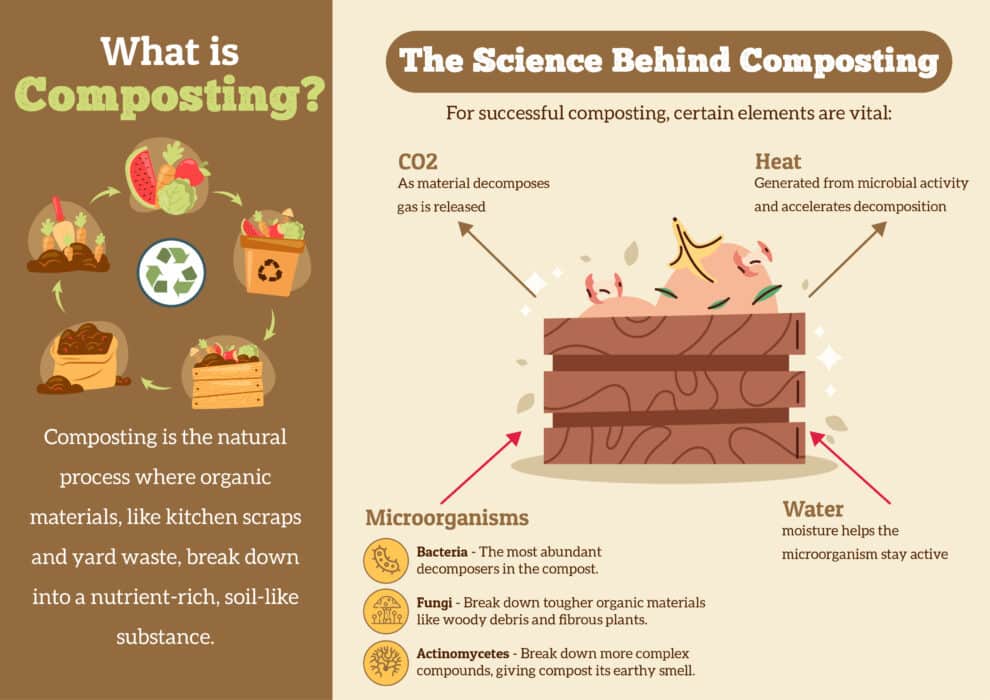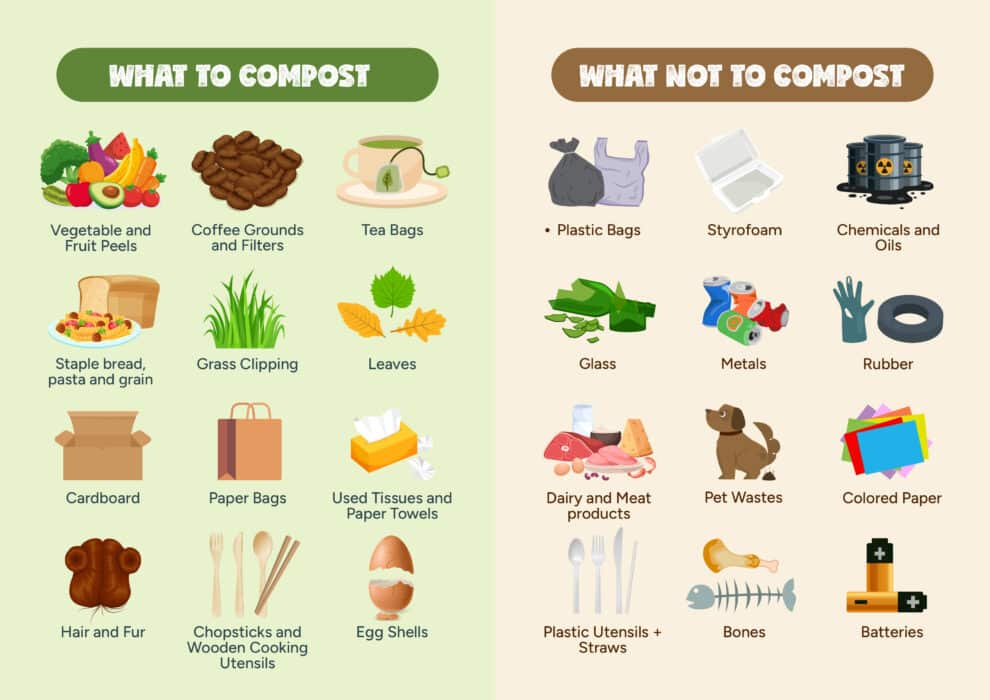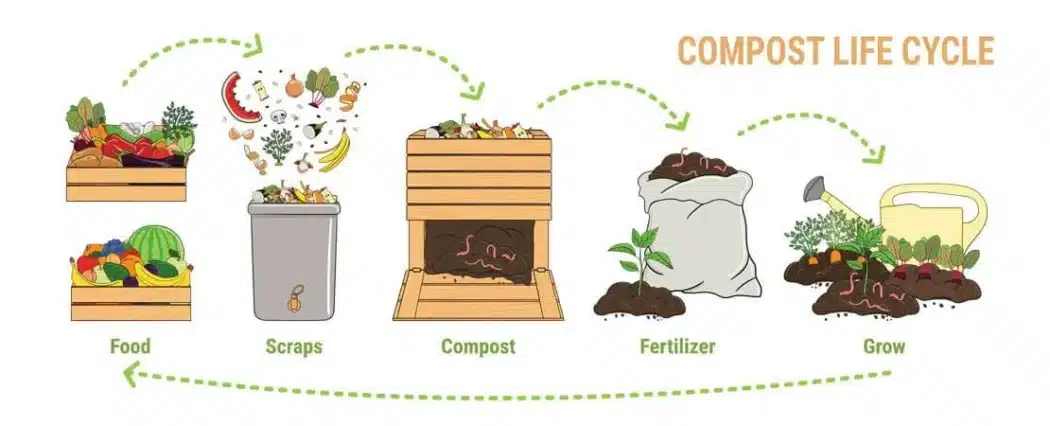In an age where landfills overflow, the need for composting has never been more pressing (1). Composting is a powerful tool that can pivot us towards a greener, more responsible future. Even better, it’s incredibly simple to implement at home and in your daily life.
Keep reading to learn just what is (and isn’t) compostable and how to get started today.
What is Composting?
Composting is the natural process where organic materials, like kitchen scraps and yard waste, break down into a nutrient-rich, soil-like substance. With the right mix of warmth, moisture, and microbial activity, compostable items decompose within months.
The Science Behind Composting
For successful composting, certain elements are vital:
- Microorganisms (2):
- Bacteria – The most abundant decomposers in the compost.
- Fungi – Break down tougher organic materials like woody debris and fibrous plants.
- Actinomycetes – Break down more complex compounds, giving compost its earthy smell.
- Heat: Generated from the microbial activity, it accelerates the decomposition. The optimal temperature is typically between 90°F (32°C) and 140°F (60°C) (3).
- Moisture: Ensures the microorganisms remain active. Balance is crucial to avoid waterlogging.
- Oxygen: Aides in aerobic decomposition, keeping the process efficient and odor-free.

The composting process consists of four distinct phases:
- Initial Phase: Fresh organic material is introduced, and microorganisms, particularly mesophilic bacteria, begin breaking down the materials.
- Thermophilic Phase: As the decomposition intensifies, thermophilic bacteria dominate, and the temperature rises, ensuring rapid decomposition of materials.
- Cooling Phase: As the easily decomposable materials are consumed, microbial activity reduces, leading to a decrease in temperature. Fungi and actinomycetes become more prevalent, tackling the tougher organic components.
- Maturation Phase: The compost stabilizes, and its properties become consistent. This phase results in the finished compost product that’s beneficial to plants and soil health.
How Long Does Compost Take?
Decomposition can take anywhere from a few weeks to several months.
Under optimal conditions with proper aeration, and balanced materials, compost can be ready in as little as 2 to 3 weeks. This requires active management, including frequent turning and monitoring of moisture and temperature.
For most home composters who might turn their compost pile occasionally and may not always have an optimal balance of materials, the process usually takes 3 to 12 months. If a compost pile is left mostly unattended, it can take a year or more for the materials to decompose fully.
What Makes an Item Compostable?
An item is compostable if it breaks down naturally into earth-friendly compost within a set period, leaving no toxins behind. Compostable items will have these attributes:
- Made from Nature: Compostable items come from plants or animals, meaning they naturally blend back into the earth.
- Breaks Down Quickly: Just like leaves or apple cores, compostable items need to decay swiftly when added to a compost pile.
- Leaves No Harmful Traces: Once fully decayed, the item shouldn’t leave any dangerous bits or chemicals behind.
- Boosts Soil Health: The decayed item adds good stuff to the soil, helping plants grow better.
Remember, an item labeled as “biodegradable” does not mean it is necessarily compostable. When determining if you can compost an item, it’s essential to look for compostable labels or gauge based on the attributes above.
Why Compost?
Composting reduces household waste, decreases the need for chemical fertilizers, saves money, and contributes to a healthier environment.
Immediate Benefits
- Soil Enrichment: Composting turns kitchen scraps and yard waste into a nutrient-rich additive for your garden. By rejuvenating the soil, compost helps plants and flowers grow healthier.
- Waste Reduction: It’s estimated that 30% of household waste can be composted (4). By diverting this from the trash, we drastically reduce the need for landfills and incinerators.
- Water Conservation: Compost improves soil’s water retention, meaning gardens require less watering. Only a 5% increase in organic material quadruples how much water the soil can hold (5). This not only conserves water but also reduces the run-off that can contaminate our waterways with pesticides and fertilizers.
- Financial Savings: By reducing charges for excess trash collection and water usage, composting translates to direct financial savings for your household.
Larger Impact
- Boosting Local Ecosystems: Healthy composted soil supports microorganisms and worms, which play a vital role in maintaining a balanced local ecosystem.
- Carbon Footprint Reduction: Composting organic materials at home prevents them from releasing methane in landfills—a potent greenhouse gas. Thus, composting directly combats climate change.
What Items are Compostable?

Kitchen Scraps
- Vegetable and fruit peels: This includes peels from root vegetables like potatoes and carrots.
- Coffee grounds and filters (6): A great addition for nitrogen.
- Eggshells: Crushed shells add calcium.
- Tea bags: Ensure they don’t contain synthetic fibers.
- Expired spices: Still organic and compostable.
- Stale bread, pasta, and grains: Break them into smaller pieces.
- Nut shells: Except walnut shells, which can be toxic to some plants.
- Cooked foods: Minus the meat and dairy.
- Dairy products: In moderation, as they can attract pests.
- Rice: Both cooked and uncooked.
Yard Waste
- Grass clippings: Fresh or dried.
- Leaves: All types and colors.
- Plant trimmings: From your garden or indoor plants.
- Weeds: Best before they seed.
- Straw and hay: Especially if it’s old or moldy.
- Pine needles: They decompose slowly but are a good source of carbon.
Paper Products
- Non-coated paper plates and napkins: Avoid the glossy, shiny kind.
- Cardboard: Including toilet paper and paper towel rolls.
- Paper bags: Without plastic liners.
- Old newspapers and magazines: Black and white pages are ideal.
- Used tissues and paper towels: As long as they aren’t contaminated with chemicals.
Textiles & Natural Materials
- Hair and fur: From all household members, two or four-legged!
- Natural fibers: Including hemp and jute.
- Feathers: Slow to decompose but completely organic.
- Cotton balls and swabs: Ensure they have paper, not plastic, sticks.
Wooden & Plant-based Items
- Wooden items: From stirrers to chopsticks.
- Cork: From bulletin boards or wine bottles.
- Sawdust: Untreated wood only.
- Bamboo: Including old bamboo toothbrushes (with bristles removed).
Others
- Lint from the dryer: As long as you’re washing natural fibers.
- Vacuum bag contents: Primarily if you have wooden or tile floors.
- Manure: From herbivores like cows, chickens, and rabbits.
- Seaweed and kelp: Rinsed to remove salt.
- Grains for livestock: Such as old or spilled feed.
For optimal decomposition, maintain the right mix of green and brown materials and ensure regular turning and aeration.
What is Not Compostable?
Plastics:
- Plastic bags: Do not biodegrade and will fragment into microplastics.
- Plastic utensils and straws: Even if labeled “biodegradable”, most require industrial facilities.
- Plastic packaging: Including wrappers and plastic film.
- Styrofoam: Does not break down and can release toxins.
Hazardous Waste:
- Batteries: Can release heavy metals and other harmful substances.
- Chemicals and oils: Disrupt the composting process and contaminate the end product.
- Pesticide-treated plants: Residues can harm beneficial composting organisms.
- Prescription medications: Not suitable for composting and should be disposed of properly.
Non-Organic Materials:
- Glass: Remains unchanged and can be hazardous in finished compost.
- Metals: Like aluminum cans or foil, which don’t decompose.
- Rubber: Including old balloons and gloves.
Potential Compost Contaminants:
- Dairy and meat products: Risk attracting pests and producing an unpleasant odor.
- Diseased plants: Can spread the disease to healthy plants when the compost is used.
- Pet wastes: From cats and dogs, can contain harmful pathogens.
- Glossy or coated paper: Often contains plastics or chemicals.
- Colored paper: Some dyes may not be compost-friendly.
Other Materials:
- Bones: They decompose very slowly and can attract pests.
- Weeds with mature seeds: Risk reintroducing them to your garden.
- Walnut shells: Can be toxic to some plants due to the presence of juglone.
For successful composting, make sure you separate these non-compostable items. This will ensure the end result is nutrient-rich and free from contaminants.
Myths and Misconceptions About Composting
When it comes to composting, a few persistent myths can make newcomers hesitant to take the plunge. Let’s take a look at some of these:
Myth 1: Composting attracts pests and rodents.
Truth: When done correctly, composting won’t attract any more critters than your garden already does. Ensure you bury food scraps well, maintain a good balance of green and brown materials, and avoid composting meat or dairy to prevent unwanted guests.
Myth 2: Composting is complicated and time-consuming.
Truth: Composting can be as simple or as intricate as you make it. Basic composting can be as straightforward as piling yard waste in a corner of your yard.
Myth 3: Composting smells bad.
Truth: A healthy compost pile should have a pleasant, earthy smell. If it smells foul, it might be too wet or have too many green materials. Adjusting the components and aerating the pile should address the issue.
Myth 4: You need a large garden or yard to compost.
Truth: Even those with limited outdoor space can compost using methods like worm composting or bokashi. Both of these methods are well-suited for smaller spaces, including apartments.
Myth 5: You can’t compost in winter.
Truth: Composting does slow down in colder months, but it doesn’t stop entirely. You can continue adding to your compost pile during winter. By spring, warmer temperatures will accelerate the decomposition process.
While there is a learning curve, the reality of composting is that anyone can do it with some practice and education.
Guide: How to Compost at Home
Composting at home is a simple yet impactful way to reduce waste and promote sustainability. Here’s a step-by-step guide to get you started:

1. Choose a Composting Bin or Pile
- Bin: Numerous compost bins are available in the market, ranging from plastic tumblers to wooden enclosures. Tumblers are convenient as they can be rotated for aeration, while wooden or wired bins allow for better air circulation.
- Pile: If you have ample space, consider just having a compost pile. It’s the simplest method—just ensure it’s contained within a designated area.
2. Decide on a Location
- Direct Sunlight: Placing your compost pile or bin in direct sunlight will speed up the decomposition process as it provides warmth. This is especially useful in cooler climates.
- Shade: If you live in a particularly hot and dry region, placing your compost in partial shade can prevent it from drying out too quickly.
3. Balancing “Greens” and “Browns”
A general rule of thumb is to aim for a 3:1 ratio of browns to greens. This balance ensures efficient decomposition.
Just what are greens and browns?
- Greens (Nitrogen-rich): Examples include fruit and vegetable scraps, coffee grounds, fresh grass clippings, and plant trimmings. They provide essential nitrogen for microbial activity.
- Browns (Carbon-rich): These include dry leaves, straw, cardboard, and paper. They provide carbon and also help with aeration by preventing the pile from becoming too compacted.
4. Maintaining the Pile
- Aeration: Regularly turn or stir your compost. This introduces air and speeds up the decomposition process, preventing foul odors and deterring pests. For tumbler bins, give them a spin every few days. For piles or static bins, use a fork or shovel to turn the materials.
Moisture: A compost pile should be moist like a wrung-out sponge but not soggy. If it’s too dry, sprinkle some water. If it’s too wet, add more browns to soak up excess moisture. - Size: A good size for a compost pile to maintain heat and foster decomposition is about 3 feet in width, length, and height.
5. Harvesting and Using the Finished Compost
Once the bottom of your pile or bin has turned into a dark, crumbly, soil-like substance, it’s ready to use! This finished compost is rich in nutrients and can be mixed into garden soil, used as a top layer for plants, or added to potting mixes.
Starting a compost system at home might seem daunting at first, but with practice and patience, it becomes an easy routine in sustainable living. The reward of nutrient-rich soil for your plants and a reduced carbon footprint makes it all worth it.
Can't Compost at Home? Here's What You Can Do
Not every living situation allows for at-home composting. Whether you’re short on space or navigating restrictions in urban settings, there are alternative routes to support and participate in the composting movement.
1. Seek Community Composting Programs
Many cities and towns offer community composting programs where residents can drop off organic waste. These programs handle the composting process on a larger scale, often catering to community gardens or public landscaping projects. Check with your local municipality or community centers to find a nearby drop-off point.
2. Worm Bins (Vermicomposting)
Worm composting, utilizes red worms to break down organic waste. It’s an efficient method for small spaces like apartments and requires little maintenance. The worms digest food scraps and produce worm castings, a rich soil amendment.
3. Bokashi Bins
An anaerobic fermentation method, bokashi composting requires specific bran filled with effective microorganisms to break down waste. Once fermented in the bin, the pre-compost can be buried in a garden or added to a traditional compost pile to complete decomposition.
4. Use a Local Composting Businesses
Some businesses focus on collecting organic waste for composting. They provide containers for households to fill, and they regularly collect and compost the waste.
These alternative options ensure that everyone can play a part in reducing waste and promoting sustainability.
Composting is an amazing practice that transforms waste into a resource. From kitchen scraps to yard trimmings, many items can be reintroduced to the environment as nutrient-rich compost. If you’re ready to start composting, creating a compost system at home is straightforward, with various methods for different living situations. And if home composting isn’t an option, community and local business initiatives can bridge the gap. Composting empowers each of us to make a tangible difference for both our gardens and the planet.
References
- Drowning in Garbage.” Washington Post, 2017. https://www.washingtonpost.com/graphics/2017/world/global-waste/
- “Compost Pile Microbes.” CalRecycle. https://calrecycle.ca.gov/organics/homecompost/microbes/
- “Temperature.” Cornell Composting, 2000. https://compost.css.cornell.edu/Factsheets/FS5.html
- “Composting at home: How to reduce your waste and make your own fertilizer.” Indiana University. https://eri.iu.edu/tools-and-resources/fact-sheets/at-home-composting.html
- “Composting and Water Conservation.” University of California, 2015. https://ucanr.edu/blogs/blogcore/postdetail.cfm?postnum=16800
- “Can You Compost Coffee Grounds? (And 10 Ways to Reuse Coffee Grounds).” Conserve Energy Future. https://www.conserve-energy-future.com/can-you-compost-coffee-grounds.php




